
The John F. Kennedy Center for the Performing Arts is the national cultural center of the United States, located on the eastern bank of the Potomac River in Washington, D.C. It was named in 1964 as a memorial to assassinated President John F. Kennedy. Opened on September 8, 1971, the center hosts many different genres of performance art, such as theater, dance, classical music, jazz, pop, psychedelic, and folk music. It is the official residence of the National Symphony Orchestra and the Washington National Opera.

The Shanghai Grand Theatre is a complex located at the intersection of Renmin Avenue and Huangpi North Road in the northern part of the People's Square in the Huangpu District of Shanghai. The building houses the Shanghai Opera House and other performing companies.
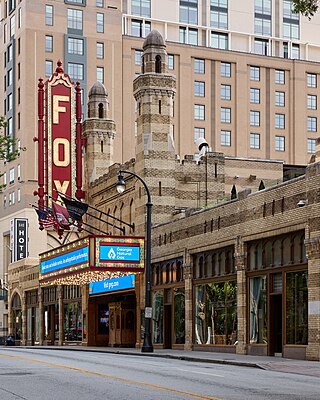
The Fox Theatre, a former movie palace, is a performing arts venue located at 660 Peachtree Street NE in Midtown Atlanta, Georgia, and is the centerpiece of the Fox Theatre Historic District.

The Fox Theatre is a performing arts center located at 2211 Woodward Avenue in Downtown Detroit, Michigan, near the Grand Circus Park Historic District. Opened in 1928 as a flagship movie palace in the Fox Theatres chain, it was at over 5,000 seats the largest theater in the city. Designed by theater architect C. Howard Crane, it was listed on the National Register of Historic Places in 1985.
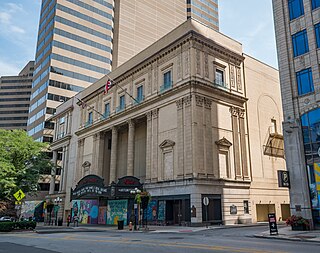
The Ohio Theatre is a performing arts center and former movie palace on Capitol Square in Downtown Columbus, Ohio. Known as the "Official Theatre of the State of Ohio", the 1928 building was saved from demolition in 1969 and was later completely restored. The theater was declared a National Historic Landmark in 1977.

The Marcus Performing Arts Center is a performing arts center in Milwaukee, Wisconsin, United States. Managed by a non-profit organization, it is marketed as Milwaukee's premier presenter of the performing arts. It is located at 929 North Water Street, at the intersection of State Street in downtown Milwaukee, and is a dedicated War Memorial.
The RiverCenter for the Performing Arts is a modern performance space in Downtown Columbus, Georgia, United States.

The Auditorium Theatre is a music and performance venue located in the Auditorium Building at 50 E. Ida B. Wells Drive in Chicago, Illinois. Inspired by the Richardsonian Romanesque Style of architect Henry Hobson Richardson, the building was designed by Dankmar Adler and Louis Sullivan and completed in 1889. The Chicago Symphony Orchestra performed in the theatre until 1904 as well as the Chicago Grand Opera Company and its successors the Chicago Opera Association and Chicago Civic Opera until its relocation to the Civic Opera House in 1929. The theater was home to the Joffrey Ballet from 1998 until 2020. It currently hosts a variety of concerts, musicals, performances, and events. Since the 1940s, it has been owned by Roosevelt University and since the 1960s it has been refurbished and managed by an independent non-profit arts organization.

The Krannert Center for the Performing Arts is an educational and performing arts complex located at 500 South Goodwin Avenue in Urbana, Illinois and on the campus of the University of Illinois Urbana-Champaign. Herman C. Krannert, an industrialist who founded Inland Container Corporation and an alumnus of the university, and his wife, Ellnora Krannert, made a gift of $16 million that led to the Krannert Center's construction. Max Abramovitz, the architect who designed the facility, was also an Illinois alumnus.
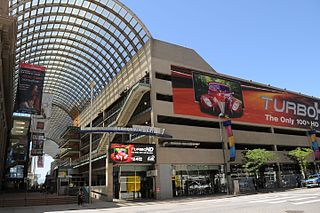
The Denver Performing Arts Complex in Denver, Colorado, is one of the largest performing arts centers in the United States. The DCPA is a four-block, 12-acre (49,000 m2) site containing ten performance spaces with over 10,000 seats connected by an 80-foot-tall (24 m) glass roof. It is home to a professional theater company and also hosts Broadway musical tours, contemporary dance and ballet, chorales, symphony orchestras, opera productions, and pop stars.
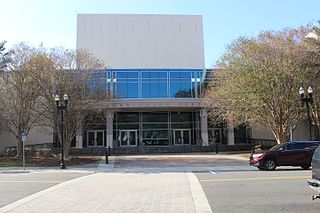
The Jacksonville Center for the Performing Arts (JCPA) is a performing arts center located in Jacksonville, Florida. Situated along the Riverbank, the venue is known as the First Coast’s "premiere riverfront entertainment facility". Originally opening in 1962, the facility was renovated beginning in 1995 until 1997; with a grand re-opening on February 8, 1997. The center consists of three venues: a theatre; concert hall and recital hall. It is home to the Jacksonville Symphony, Jacksonville Symphony Youth Orchestra, and the FSCJ Artist Series.

Heinz Hall is a performing arts center and concert hall located at 600 Penn Avenue in the Cultural District of Pittsburgh, Pennsylvania. Home to the Pittsburgh Symphony Orchestra (PSO) and the Pittsburgh Youth Symphony Orchestra, the 2,676 seat hall presents about 200 performances each year. Originally built in 1927 as Loew's Penn Theatre, the former movie palace was renovated and reopened as Heinz Hall in 1971.
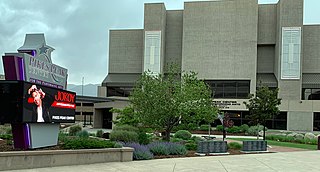
The Pikes Peak Center for the Performing Arts is a concert auditorium in Colorado Springs, Colorado. It serves as an entertainment, cultural, educational, and assembly center for the citizens of El Paso County, the Pikes Peak region, and the surrounding area.

An atmospheric theatre is a type of movie palace design which was popular in the late 1920s. Atmospheric theatres were designed and decorated to evoke the feeling of a particular time and place for patrons, through the use of projectors, architectural elements and ornamentation that evoked a sense of being outdoors. This was intended to make the patron a more active participant in the setting.

The Saenger Theatre is a historic theater and contributing building to the Lower Dauphin Street Historic District in Mobile, Alabama. It was dedicated in January 1927. The Saenger Theatre is a Mobile landmark, known for its architecture and ties to local cultural history. The theater has been completely renovated in recent years with an upgraded electrical system, VIP facilities, new stage rigging and sound system. It is the official home of the Mobile Symphony Orchestra and also serves as the venue for movie festivals, concerts, lectures and special events.

The Music Hall Center for the Performing Arts is a 1,731-seat theatre located in the city's theatre district at 350 Madison Street in Downtown Detroit, Michigan. It was built in 1928 as the Wilson Theatre, designated a Michigan State Historic Site in 1976, and was listed on the National Register of Historic Places in 1977.
The Emery Theatre, or Emery Auditorium, is a historic, acoustically exceptional theater located in the Over-the-Rhine neighborhood of Cincinnati, Ohio. The building was constructed in 1911 as the home for a trade school, but its large auditorium was intended for public use. The design of the Emery Theatre is based on the "isacoustic curve" principles that were first proposed by John Scott Russell. The theatre was built with two balconies and a total of 2,211 seats. It was one of the first concert halls in the United States to have no obstructed seats.

The Smith Center for the Performing Arts is a 5-acre (2.0 ha) performing arts center located at Symphony Park in Downtown Las Vegas, Nevada. Consisting of three theaters in two buildings, the performing arts center is designed in the Neo Art Deco style. The architectural style was chosen by David M. Schwarz to echo the design elements of the Hoover Dam, just 30 miles (48 km) to the southeast. It also shares design features with the Will Rogers Memorial Center in Fort Worth, Texas. The center features a 17-story carillon tower containing 47 bells and is the first performing arts center in the nation to be Gold LEED certified. Groundbreaking for the $470 million complex began on May 26, 2009, and it opened on March 10, 2012.

The Vahdat Hall, formerly the Roudaki Hall, is a performing arts complex in Tehran, Iran.

The Tobin Center for the Performing Arts is San Antonio's performing arts center. Located next to the San Antonio Riverwalk, it is named for Robert L. B. Tobin, one of the city's most prominent residents.






















